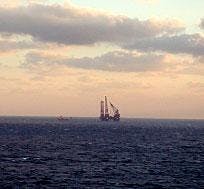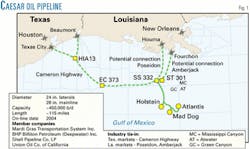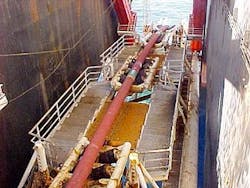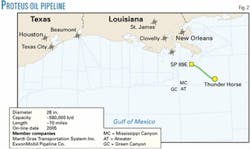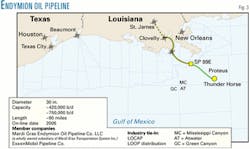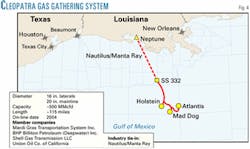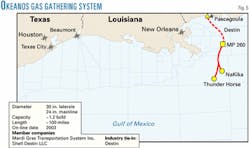Richard J. Black
Lawson L. Freeman
Jaime A. Calderon
BP America Inc., Houston
Construction on the groundbreaking Mardi Gras transportation system in deepwater Gulf of Mexico by BP America Inc. and partners is well under way.
Upon completion, the Mardi Gras system will be the largest-capacity deepwater pipeline system ever built, capable of transporting more than 1 million b/d of oil and 1.5 bcfd of gas. The large-diameter pipelines of the $1-billion system will extend 485 miles across the central and western gulf in water as deep as 7,300 ft (see Fig. 1 in Part 1; OGJ, May 5, 2003, p. 84).
Part 1 of this two-part series on the project set out several of its most important "firsts"; this conclusion will focus on its major segments. Three oil and two gas pipelines—with diameters ranging from 24 to 30 in. for oil and from 16 to 24 in. for gas—will begin at steel catenary risers on deepwater host platforms.
Named after Mardi Gras parades in New Orleans, the pipelines will extend to booster platforms in the shallower water of the continental shelf, with the exception of the Endymion oil pipeline, which will extend from the South Pass area of the shelf to Grand Isle, La., terminating at Clovelly, La.
The system will provide BP, its partners in key oil and gas fields, and operators of existing and potential discoveries in the southern Green Canyon and Mississippi Canyon areas access to a nearby transportation infrastructure consisting of world-class deepwater pipelines, many of which are setting records for water depth and diameter (see Part 1).
In addition, the Mardi Gras system was designed to give these pipelines access to multiple processing facilities and onshore pipelines all along the Gulf Coast.
Project conception
Typically, companies develop new discoveries in the Gulf of Mexico by building a transportation system that connects to existing infrastructure nearby. Because of BP's multiple exploration successes in 1999-2000 in deepwater areas where no infrastructure existed, the company decided to fill a void by developing its own deepwater oil and gas transportation system.
The five-pipeline Mardi Gras system, as conceived by BP, seeks not only to provide a transportation infrastructure for its own deepwater developments, but also to build a commercial venture to serve other producers in highly prospective regions of the Gulf of Mexico.
null
BP achieved this by focusing its efforts on two distinct corridors where existing and potential discoveries by other parties are likely to seek transportation:
- Southern Green Canyon, where BP has interests in the Holstein, Mad Dog, and Atlantis oil and gas discoveries.
- Mississippi Canyon, where it has interests in the Thunder Horse and Na Kika oil and gas discoveries.
Following are BP's projects and facility locations:
- Holstein, in 4,300 ft of water on Green Canyon Block 645, owned 50% by BP and 50% by Shell Oil Co., to be equipped with a 100,000 b/d, 90-MMcfd spar.
- Mad Dog, in 4,500 ft of water on Green Canyon Block 826; owned 60.5% by BP, 23.9% by BHP Billiton Petroleum (Deepwater) Inc., and 15.6% by Union Oil Co. of California Corp.; to be equipped with an 80,000 b/d, 40-MMcfd spar.
- Atlantis, in 4,500-6,900 ft of water on Green Canyon Block 743, owned 56% by BP and 44% by BHP Billiton, to be equipped with a 150,000 b/d, 180-MMcfd semisubmersible platform.
- Thunder Horse (formerly Crazy Horse), in 5,600-6,500 ft of water on Mississippi Canyon Block 778, owned 75% by BP and 25% by ExxonMobil Corp., to be equipped with a 250,000 b/d, 200-MMcfd semisubmersible platform with production, drilling, and quarters.
- Na Kika, in 5,800-7,000 ft of water on Mississippi Canyon Block 474, owned 50% by BP and 50% by Shell, to be equipped with a 110,000 b/d, 425-MMcfd semisubmersible platform.
BP kept one goal in mind when designing the five-pronged Mardi Gras system to serve these fields and discoveries in the surrounding areas: For each project segment, the company sought to transport oil and gas production to a fungible market center to provide shippers with flexibility in marketing their production.
As a result, each segment connects to attractive downstream markets with multiple shipping options.
The pipelines also are oversized relative to the baseload fields. And, they are designed to enable subsea connection of new production—via a system of deepwater wye sleds and jumpers—without affecting existing production.
The oil pipelines will employ a quality bank that provides shippers a market-based compensation system between shippers, based on the quality of crude delivered to the pipeline.
All of these factors should lower the commerciality hurdle for other E&P companies with nearby discoveries and make the economics of the projects' segments such that each can compete aggressively with other shipping options.
Project structure
BP sanctioned development of the Mardi Gras transportation system in May 2001. The system will consist of five pipelines, built and owned by separate entities comprised of BP and its partners in the deepwater oil and gas developments:
- The Caesar Oil Pipeline, with a capacity of 450,000 b/d from the Holstein-Mad Dog-Atlantis area.
- The Cleopatra Gas Gathering System, with a capacity of about 500 MMcfd from the Holstein-Mad Dog-Atlantis area.
- The Okeanos Gas Gathering System, with a capacity of 1.2 bcfd from the Thunder Horse-Na Kika area.
- The Proteus Oil Pipeline, with a capacity of 420,000 b/d from the Thunder Horse semisubmersible platform area.
- The Endymion Oil Pipeline, with a capacity of 420,000 b/d from the Proteus terminus on South Pass Block 89E to the Louisiana Offshore Oil Port (LOOP) at Clovelly, La.
All pipelines will be operated by Mardi Gras Transportation System Inc., a BP America subsidiary.
Oil pipelines
In the Green Canyon area, BP and partners BHP Billiton Petroleum, Shell Pipeline Co. LP, and Union Oil Co. of California formed Caesar Oil Pipeline Co. LLC to undertake construction of the Caesar pipeline. This 450,000-b/d line will consist of a 28-in. mainline and 24-in. laterals to the Holstein and Mad Dog spars and the Atlantis semisubmersible platform.
Caesar will transport southern Green Canyon oil production to a booster platform on Ship Shoal Block 332 on the continental shelf (Fig. 1). BP has reached an agreement with El Paso Energy Partners LP to connect the Caesar pipeline with the 380-mile Cameron Highway pipeline, which is under construction. This line can deliver oil to refining centers at Texas City and Beaumont, Tex.
null
With the potential of tie-ins in the future, it will be possible to connect Caesar with the El Paso Energy Partners LP-operated Poseidon Oil Pipeline system, which transports oil to Houma, La., or with the Shell-operated Amberjack pipeline, which delivers into the LOOP storage facilities at Clovelly.
The Caesar project is due on line in 2004.
In Mississippi Canyon, BP and ExxonMobil Pipeline Co. formed Proteus Oil Pipeline Co. LLC to build the Proteus pipeline from the Thunder Horse semisubmersible platform to a new-build platform, to be installed on South Pass Block 89E in about 400 ft of water (Fig. 2). The platform will enable tie-in of shelf discoveries in the area, as well as the future installation of 50,000-hp pumps to increase pipeline capacity, when needed.
This 28 in. high-pressure line will have an installed capacity of 420,000 b/d, expandable to 580,000 b/d.
The related 30-in. Endymion pipeline–undertaken by another BP-ExxonMobil Pipeline Co. entity, Endymion Oil Pipeline Co. LLC–will have a capacity of 420,000 b/d, expandable with booster pumps to 750,000 b/d. The oil will be transported from South Pass 89E to landfall at Grand Isle, then on to the LOOP facilities (Fig. 3).
Oil shipped in the Proteus and Endymion lines will have access to southern Louisiana area refineries, via pipelines, including LOCAP LLC's line from Clovelly to St. James, La.; the Clovelly-Alliance-Meraux line; and Shell Oil Pipeline to Norco, La., and Texas.
Proteus and Endymion are due on stream in 2005.
Gas pipelines
The Cleopatra pipeline—owned by Cleopatra Gas Gathering Co. LLC, an entity owned by BP, BHP Billiton Petroleum, Shell Gas Transmission, and Union Oil—will run in dense phase parallel to Caesar, gathering natural gas from Holstein, Mad Dog, and Atlantis fields and up the Sigsbee Escarpment to the SS 332 platform (Fig. 4). This 500-MMcfd line will consist of a 20-in. main line and 16-in. laterals to the fields.
null
Maintaining pressures at or greater than 1,700 psi will keep operations in dense phase to prevent problems related to slug and two-phase flow that would be expected to develop, particularly on the portion of the line that climbs the steep grade of the Sigsbee Escarpment.
From SS 332, gas will be gathered via the Manta Ray Offshore pipeline to the Nautilus pipeline and to the Neptune processing plant, providing shippers with access to multiple gas delivery options and to the South Louisiana NGL infrastructure.
Cleopatra is scheduled to come on stream in 2004.
The first Mardi Gras pipeline to begin operations will be Okeanos, owned by Okeanos Gas Gathering Co. LLC, with member companies BP and Shell Destin LLC. This 1.2-bcfd line will connect the Thunder Horse and Na Kika semisubmersible platforms via 20-in. laterals to a 24-in. main line that extends to Main Pass Block 260 (Fig. 5).
From there, Okeanos gas will be shipped in the BP-operated Destin gas pipeline, which is owned two-thirds by BP and one-third by Shell Gas Transmission. Destin Pipeline gives shippers market access with connections to six major interstate onshore pipelines, including the recently completed Gulfstream pipeline to Florida and to natural gas storage.
null
Destin has recently been expanded from 1.0 bcfd to 1.2 bcfd with future expansions possible. Okeanos is scheduled for start-up in late 2003.
The authors
Richard J. Black served as vice-president of Mardi Gras Transportation System Inc. during commercial development of the project. He has 20 years' experience in the midstream business including business development, engineering, and operations. Black holds a BS (1983) in mechanical engineering from Oklahoma State University and is a member of the Gas Processors Association and the National Energy Suppliers Association.
Lawson L. Freeman (freemall @bp.com) is midstream manager for the Gulf of Mexico at BP and was previously the gas team leader for the Mardi Gras project. He holds a BS (1985) in petroleum engineering from Texas A&M University and is a member of the Gas Processors Association and Society of Petroleum Engineers.
Jaime A. Calderon (calderja @bp.com) is midstream commercial team leader for BP and was previously the oil team leader for the Mardi Gras project. He has held various midstream management positions within BP since 1992 and the Colombian oil industry 1985-1992, including involvement in the development of the Caño Limon, Oleoducto de Colombia, and OCENSA pipeline systems. After moving to Houston in 1998, he has been involved in the commercial development of gulf transportation projects (Ursa oil and gas transportation systems, expansion of the Mars Oil Pipeline, floating storage offloading and tankering feasibility for the gulf, and Mardi Gras). He was trained as an industrial engineer (1984) at the Pontificia Universidad Javeriana, Bogotá, and holds an MA (1988) in finance from the Universidad de Los Andes, Bogotá. Calderon is a member of the Sociedad de Ingenieros Javerianos.
